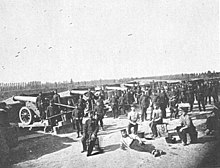Siege of Strasbourg
This article needs additional citations for verification. (March 2018) |
| Siege of Strasbourg | |||||||
|---|---|---|---|---|---|---|---|
| Part of the Franco-Prussian War | |||||||
 Strasbourg in ruins after the siege | |||||||
| |||||||
| Belligerents | |||||||
|
|
| ||||||
| Commanders and leaders | |||||||
|
|
| ||||||
| Strength | |||||||
| 40,000 | 23,000 | ||||||
| Casualties and losses | |||||||
| 906–933 killed and wounded |
20,000 military casualties Military losses 861 dead[1] 1,500 wounded 17,562 men, 1,277 artillery pieces 140,000 rifles 50 locomotives captured Civilian losses 341 civilians killed 600–2,000 civilians wounded | ||||||
The Siege of Strasbourg took place during the Franco-Prussian War, and resulted in the French surrender of the fortress on 28 September 1870.
After the German victory at Wörth, troops from the Grand Duchy of Baden under Prussian General August von Werder were detached to capture Strasbourg with the help of two Prussian Landwehr divisions which had been guarding the North Sea coast. This 40,000-strong siege corps reached the fotress on 14 August and began to immediately bombard it. The city's defenses were largely obsolete and 7,000 of the 23,000-strong garrison were National Guard militiamen. Desiring a quick surrender, the Germans began a terror bombardment to destroy the morale of the civilian population on 23 August. Explosive and incendiary shells were rained down on the city for four days and entire quarters of the city were reduced to ash. Panic developed in the city but there was no capitulation.[2]
A shell shortage forced Werder to lower the intensity of the German fire on 26 August. He switched to formal siege operations instead. The Germans dug their way closer to the fortress through trench parallels and destroyed specific sections of the defenses with concentrated bombardments. The siege progressed rapidly, French sortie attempts were defeated and by 17 September the enceinte wall had been breached. At the same time, the city's morale was lowered by news of the annihilation of the Army of Châlons at Sedan and the encirclement of the Army of the Rhine in Metz.[3]
On 19 September the Germans captured their first outwork and began a devastating close-range bombardment of the city. With the city defenseless and a German assault imminent, the French commander General Uhrich surrendered the fortress, 17,562 troops, 1,277 artillery pieces, 140,000 rifles, including 12,000 Chassepots, 50 locomotives and considerable stores of supplies into German hands on 28 September. The Germans had lost 933 officers and men killed or wounded.[4] They fired an average of 4,220 shells into the city and its surrounding defenses every day for six weeks. Some 861 French soldiers died from all causes by the end of the siege and 1,500 were wounded. A total of 341 civilians were killed by the bombardment and a further 600–2,000 wounded. The deliberate German targeting of civilian morale presaged the total wars of the 20th century.[5][6]
Background
After the Battle of Wörth, Crown Prince Frederick detached General August von Werder to move south against the fortress of Strasbourg. At the time, Strasbourg (along with Metz) was considered to be one of the strongest fortresses in France. Werder's force was made up of 40,000 troops from Württemberg and Baden, which lay just across the Rhine from Strasbourg. The French garrison of 17,000 was under the command of the 68-year-old General Jean Jacques Alexis Uhrich.
Initial bombardment
Werder understood the value of capturing the city, and ruled out a lengthy siege of starvation. He instead decided on a quicker action, bombarding the fortifications and the civilian population into submission.
On 23 August Werder's siege guns opened fire on the city and caused considerable damage to the city and many of its historical landmarks. The Bishop of Strasbourg went to Werder to beg for a ceasefire, and the civilian population suggested paying 100,000 francs to Werder each day he did not bomb the city. Uhrich refused to relent, and soon enough Werder realized he could not keep up such a bombardment with the amount of ammunition he had.
On 24 August, the Museum of Fine Arts was destroyed by fire, as was the Municipal Library housed in the Gothic former Dominican Church, with its unique collection of medieval manuscripts, rare Renaissance books and Roman artifacts.
Siege

Werder continued bombing the city, this time targeting selected fortifications. The German siege lines moved rapidly closer to the city as each fortress was turned into rubble. On 11 September, a delegation of Swiss officials went into the city to evacuate non-combatants. This delegation brought in news of the defeat of the French at the Battle of Sedan, which meant no relief was coming to Strasbourg. On 19 September the remaining civilians urged Uhrich to surrender the city, but he refused, believing a defense was still possible. However, that same day Werder stormed and captured the first of the city's fortifications. This event caused Uhrich to reconsider his ability to defend the city. On 27 September Uhrich opened negotiations with Werder, and the city surrendered the following day.
Aftermath


The fall of Strasbourg freed Werder's forces for further operations in northeastern France. His next move was against the city of Belfort, which was invested in November. Strasbourg was ceded to Germany in the Treaty of Frankfurt on 10 May 1871.
Citations
- ^ Chrastil 2014, p. 110, of which 270 killed in action, 445 died from wounds, 146 of sickness.
- ^ Howard 1991, p. 217.
- ^ Howard 1991, p. 218.
- ^ Chrastil 2014, p. 220.
- ^ Chrastil 2014, p. 110.
- ^ Howard 1991, pp. 218–219.
References
- Howard, M. (1991) [1962]. The Franco-Prussian War: The German Invasion of France 1870–1871. New York: Routledge. ISBN 0-415-26671-8.
{{cite book}}: Invalid|ref=harv(help) - Chrastil, Rachel (2014). The Siege of Strasbourg. Cambridge, MA: Harvard University Press. ISBN 978-0-674-72886-8.
{{cite book}}: Invalid|ref=harv(help)
